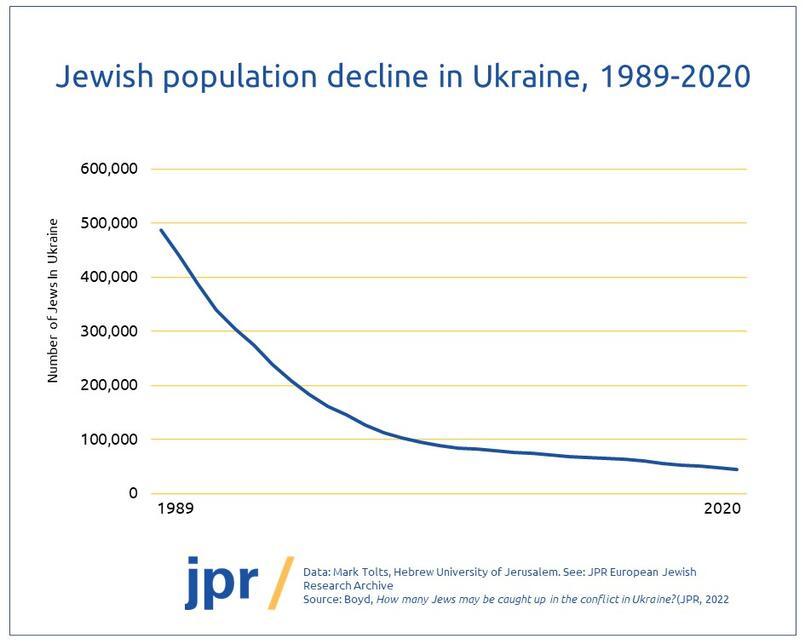There were just over 40,000 self-identifying Jews in Ukraine on the eve of the conflict with Russia; the population has declined 91% over the past thirty years
Dr Jonathan Boyd
and test your family's knowledge of Jews worldwide while reading the Haggadah!
Dr Jonathan Boyd
Discussions about how many Jews live in a given country often descend into the realm of fantasy – the numbers quoted variously be journalists, commentators, community leaders and politicians are often way off the mark. Whether out of ignorance, carelessness, or an overblown sense of self-importance, some of the claims made over the years have been nothing short of pure fantasy.
There was a good example in The Times recently, just as the conflict in Ukraine began. The journalist in question maintained that there are 400,000 Jews living in Ukraine today, a figure so far off the mark as to be a shoo-in for the shortlist of most far-fetched Jewish population claims of 2022.
But in truth, it’s very difficult to come up with an estimate, particularly in countries such as Ukraine, which were under Soviet control for decades. With religious aspects of Judaism strongly suppressed in the Soviet Union and Yiddish culture all but destroyed after the Second World War, Soviet Jews were left with an extremely limited knowledge of Jewish religion or culture, able only to be identified as Jews by nationality or to affirm their Jewishness on the grounds of being part of a minority group with common ancestry. Intermarriage and assimilation became increasingly common, making the boundaries between who is and who is not Jewish increasingly difficult to draw.
In part because of this, Jewish demographers measure the size of Jewish populations today using four different inclusion criteria. The most common one is what is known as the ‘core’ Jewish population: it includes anyone who, when asked in a survey or census questions such as ‘what is your religion?’ or ‘what is your ethnicity?’, responds by self-identifying as Jewish. As of 2021, the year before the conflict broke out, number of Jews in Ukraine was about 43,000 according to this criterion.
The second definition used enumerates the ‘population with Jewish parents.’ This includes most of those in the core Jewish population, but adds others who do not consider themselves to be Jewish yet have at least one Jewish parent. Given that Jewishness is seen more as a matter of ancestry than religion in Ukraine, this is an important approach there. Demographers estimate the population based on this criterion at 90,000 in 2021.

Then there is what is known as the ‘enlarged Jewish population’ – including anyone who self-identifies as Jewish, plus anyone else living within their household, such as their spouse or children, irrespective of whether they are Jewish or not. Again, this is an important consideration in places such as Ukraine: when Jewish organisations provide care or support for Jews there, it would be wrong to limit that only to the Jewish partner in a mixed couple – imagine delivering a hot meal to an elderly impoverished Jewish man, but not to his equally impoverished and elderly non-Jewish wife. Using this criterion, the 2021 population is estimated at 140,000.
Finally, there is the ‘Law of Return population’ – i.e. the number of people eligible for Israeli citizenship under the terms of Israel’s Law of Return. This applies to anyone who is the descendant of at least one Jewish grandparent, irrespective of whether or not they personally identify as Jewish, and it extends to their immediate family members living within their household, again, irrespective of whether or not they see themselves as Jewish. Using this as our criterion, the 2021 population reaches about 200,000.

So, as you can see, the 400,000 claim is way off. But then again, it might just be excusable. Why? Because just over thirty years ago, when the Berlin Wall came down, the core Jewish population of Ukraine numbered 487,000. It has declined year-on-year since then, very rapidly during the 1990s due largely to out-migration, slowing somewhat during the 2000s, before speeding up again following the 2014 unrest. In fact, the Jewish population of Ukraine is estimated to have declined by 91% over the past three decades. And bearing in mind the likely effects of the war with Russia, further decline is inevitable.
Executive Director
Executive Director
Jonathan has been Executive Director of JPR since 2010, having previously held research and policy positions at the JDC International Centre for Community Development in...
Read more